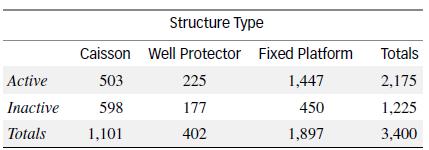Refer to the Oil & Gas Journal (Jan. 3, 2005) study of 3,400 oil and gas structures
Question:
Refer to the Oil & Gas Journal (Jan. 3, 2005) study of 3,400 oil and gas structures in the Gulf of Mexico, Exercise 3.19. The accompanying table breaks down these structures by type (caisson, well protector, or fixed platform) and status (active or inactive). Assume the 3,400 structures are a representative sample of all oil and gas structures worldwide.

a. Conduct a test (at α = .10) to determine if the proportion of caisson structures that are inactive exceeds the proportion of well protector structures that are inactive.
b. Conduct a test (at α = .10) to determine if the proportion of caisson structures that are inactive exceeds the proportion of fixed platform structures that are inactive.
c. Conduct a test (at α = .10) to determine if the proportion of well protector structures that are inactive differs from the proportion of fixed platform structures that are inactive.
Data from Exercise 3.19
U.S. federal regulations require that operating companies clear all inactive offshore oil and gas structures within one year after production ceases. Researchers at the Louisiana State University Center for Energy Studies gathered data on both active and inactive oil and gas structures in the Gulf of Mexico (Oil & Gas Journal, Jan. 3, 2005). They discovered that the gulf had 2,175 active and 1,225 idle (inactive) structures at the end of 2003. The table on pg. 94 breaks down these structures by type (caisson, well protector, or fixed platform).
Step by Step Answer:

Statistics For Engineering And The Sciences
ISBN: 9781498728850
6th Edition
Authors: William M. Mendenhall, Terry L. Sincich





